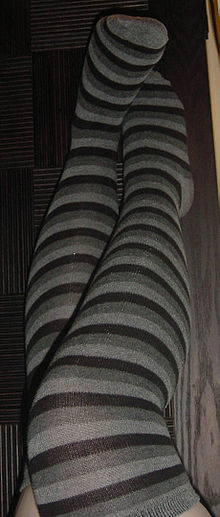Footwear
This usually takes place in situations of captivity, such as imprisonment or slavery, where the groups are among other things distinctly divided by whether or not footwear is being worn.
Similarly, deliberately forcing other people to go barefoot while being shod oneself has been used to clearly showcase and convey one's superiority within a setting of power disparity.
Similarly, ancient China considered footwear an important aspect of civilization—particularly embroidered slippers—but often depicted Taoist immortals and gods like Xuanwu barefoot.
The Book of Exodus records Moses reverentially removing his shoes at Mount Sinai and the priests likewise went barefoot at the Temple of Solomon before Babylonian customs prevailed and entering houses of worship in footwear became common in Judaism[9][10] and Christianity.
By the High Middle Ages, fashion trends periodically prompted sumptuary taxes or regulations and church condemnation for vanity.
The stiff hose of the era usually required fairly soft footwear, which in turn was easier to damage in the dirt and muck of the street and outdoors.
(Turkish sources, meanwhile, credit the chopines directly to the nalins worn in Ottoman baths and whose height was considered to be a marker of status.
Welting was developed, using a narrow band of leather between the uppers and sole to improve appearance and comfort, increase water resistance, and simplify repair, particularly resoling worn shoes.
Its demand for masses of low-quality shoes for its slaves was met by workshops around Boston, Philadelphia, and New York, a dependence that later hobbled the Confederate Army during the Civil War[22] and was responsible in legend for the decisive Battle of Gettysburg.
[23] Amid the Industrial Revolution, John Adam Dagyr's introduction of assembly line production[14][24] and tight quality control[25] to the "ten-footer" workshops[26] in Lynn, Massachusetts, US, around 1760 is sometimes credited as the first shoe factory.
[1] However, although mechanized textile mills greatly reduced the price of proper socks, each step of the shoemaking process still needed to be done by hand in a slowly optimized putting-out system.
[24][27] The first mechanized systems—developed by Marc Isambard Brunel in 1810 to supply boots to the British Army amid the Napoleonic Wars—failed commercially as soon as the wars were over because the demobilized soldiers reduced the price of manual labor.
[28] John Brooks Nichols's 1850 adaptation of Howe and Singer's sewing machines to handle binding uppers to soles[29] and the Surinamese immigrant Jan Ernst Matzeliger's 1880 invention of an automatic lasting machine finally allowed true industrialization, taking the productivity of individual workers from 20 or 50 pairs a day to as many as 700, halving prices,[24][30] and briefly making Lynn the center of world shoe production.
The prevalence of trench foot in World War I focused attention on the importance of providing of adequate footwear in following conflicts, although this was not always possible.
Major brands such as Converse, Adidas, and Nike used celebrity endorsements from Chuck Taylor, Michael Jordan, Lionel Messi, and others to promote their products.
[36] In their turn, the Hong Kong manufacturers began moving production to Guangdong in mainland China almost immediately after the establishment of Deng Xiaoping's Opening Up Policy in the early 1980s.
[36] Competitors were soon forced to follow suit, including removal of Taiwanese and Korean[38] production to Fujian and to Wenzhou in southern Zhejiang.
[36] Similarly, amid Perestroika and the Fall of Communism, Italy dismantled its domestic industry, outsourcing its work to Eastern Europe, which proved less dependable than the Chinese and further eroded their market share.
By producing footwear in accordance with national and international regulations, potential risks can be minimized and the interest of both textile manufacturers and consumers can be protected.











